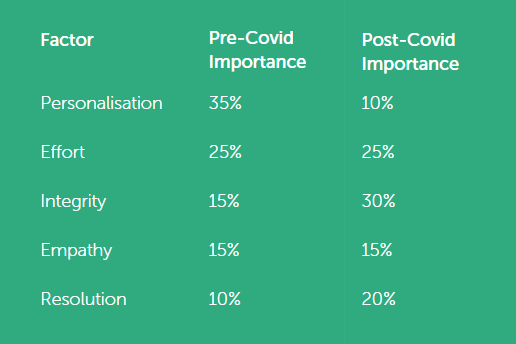
The evolution of the customer and employee experience
As organisations reflect on key learnings and insight gained over the last couple of years and continue to navigate the ‘new normal’, how have the roles of Customer and Employee Experience evolved? And how do businesses continue to settle into their new normality while preparing for an uncertain future?
The pandemic is ongoing; there is always the possibility of new variants that could bring life to a standstill again. Not only that, but the rising cost of living and the “great resignation” is impacting businesses the world over.
So much has been written about the far-reaching effects of COVID-19. And understandably so. It’s the single biggest disruptor any of us will have lived or worked through. It has affected our health, day-to-day lives, jobs, financial security, and the well-being of our loved ones. Simple, basic liberties we took for granted have been threatened and placed out of bounds. Who would ever have thought at the start of 2020 that one of the most dangerous things we could potentially do this year would be to hug and embrace an elderly relative?
And yet, this was our reality for a long period of time.
The end of the beginning…Or the beginning of the end?
As lockdown measures started to be cautiously lifted, our children returned to normality by going back to school, and businesses welcomed colleagues back to physical offices, many of us will be asking ourselves if this is the end of the beginning… or is it the beginning of the end? Or is there even an ‘end’ to this pandemic? Public Health officials are managing expectations by suggesting there might never be an ‘end’. And hopes of a full return to our ‘normal’ lives are unrealistic. Similarly, from a business perspective, ‘business as usual’ no longer applies. This isn’t necessarily a bad thing; some employees have thrived during the work-from-home mandates, discovering more work/life balance and greater emphasis placed on health and wellbeing.
The adage of happy people means happy customers have long been understood; although arguably not effectively embedded across all organisations. But the inextricable linkage between Customer and Employee Experience has never been more pronounced. They go hand in glove; listening to customers and employees, and acting on their feedback, is more important now than ever before.
Recent cross-industry research and analysis into the impact of COVID-19 on Customer Experience were very revealing.
Taking input and feedback across all sectors on what mattered most to customers now versus their expectations pre-COVID highlighted the following:-

Whilst there were slight nuances across sectors, the key message was consistent. The thing that matters most to customers when interacting with an organisation was INTEGRITY. This was closely followed by the amount of perceived effort a customer has to make in interacting with a brand i.e. how easy is it to do business with?
*Source: Watermelon Research
Interestingly this notion of INTEGRITY extends beyond how a brand treats its customers. Interpretations of a brand’s integrity are based on a much wider lens and will now include a customer’s perception of how an organisation treats its employees, an assessment of the organisation’s wider supply chain, and the partners they choose to work with.
The relative ease with which a customer can engage with a brand has risen in importance. The acceleration in digital adoption by both businesses and customers has been experienced across all sectors. It was reported that digital adoption increased by the equivalent of 10 years in  space of 8 weeks. There was a 250% uplift in WhatsApp messaging as customers and businesses leaned into and embrace new channels of communication. The 65+ age bracket saw the biggest transformation in digital engagement, as businesses and customers alike sought new ways to connect.
Real opportunities for customer intimacy
Whilst the rise of digital tools and adoption was a key theme in the pandemic, allowing teams to build efficiency and create capacity in low-value tasks, this is against a backdrop of increased customer vulnerability across more fronts than ever before. Worries about health, job stability, and financial security have meant the profile of customer contact has changed too. Customer demand for specialist teams requiring increased compassion, empathy, and connection has never been as high, creating real opportunities for customer intimacy.
The need for employees to support increasingly complex and emotional customer interactions has risen too. The challenge for businesses is therefore to find that perfect balance. That sweet spot of humans and automation. It’s not a binary case of people vs robots. Both channels have their role to play in supporting the different needs of customers. But the critical challenge for businesses is to recognise the role different channels can play in best supporting different customer journeys.
Businesses should not underestimate the far-reaching effects the pandemic has had on its customers. All businesses must re-learn what their customers want, what they need and expect from them. It would be naïve to assume that what mattered pre-pandemic still carries the same importance. So, don’t play down the impact of the last two years on your customers’ expectations and needs of your products and services.
Contact centres have often been the ‘poor relation’ in many organisations. However, during COVID-19 times, as businesses had to shut ‘shop’ and furlough their front-line teams, the stalwart contact centre has become THE front line. THE key conduit to customer experience. This has facilitated an exciting shift in the wider appreciation of the role contact centre teams play in the delivery of the end-to-end customer experience, enabling increased collaboration across business functions. Internal perceptions have changed and improved. Those who view the contact centre as a “source of insight” grew considerably during the pandemic, from 37% to 48%* Teams are listening to the voice of the front line contact centre agent, sharing and replaying the voice of the customer. The insight gained across multiple channels and customer journeys from your contact centre teams should now be informing your critical business decisions and future transformation plans.
Whilst this has been a hugely worrying and unsettling time for customers, employees have also had to face into similar challenges and concerns. As customers’ expectations have changed during this pandemic, the way in which employees work and how they interact with customers has changed too.
So what do this changing landscape and these evolving priorities mean for your employee experience?
Gartner estimated that 88% of organisations encouraged employees to work from home during lockdown. In the UK contact centre sector, 4 out of 5 contact centre operations still have AT LEAST 50% of their agents working remotely. Innovative contact centre operations have recognised the benefits of remote, flexible teams for some time now. As they emerged from numerous lockdowns, management listened to what employees wants and implemented hybrid working as a permanent feature. They’re focused on providing health and wellbeing and prioritising collaboration and connection for a workforce that is both office and home-based. But for most operations, leaders haven’t had any experience of leading remote teams. Nor has it even been in their consciousness that this was even a probability they should plan for! So, the change to mobilise remote teams in this way was VAST and FAST. In some cases, almost overnight.
And whilst this remote mobilisation might have been initially viewed as a short-term tactical solution, it is now expected that these new remote working practices will be a permanent feature in operating models going forward. High levels of employee satisfaction are being reported, driven by the removal of stressful commuting time and increased flexibility with shifts and working patterns. Businesses are also seeing benefits in increased productivity, improved customer satisfaction, and reduced operational costs.
As flexible home working is now the norm organisations are turning their attention to employee benefits and offering a considered, competitive package: health and wellbeing initiatives, plans for upskilling, bonuses, and rewards. Leaders are pivotal in guiding training and development and assessing employee needs. Continuing to provide professional development, and ensure leaders are capable of managing a remote workforce, is to future-proof company strategy,
Whilst the benefits of remote, flexible working is recognised, it is important to also acknowledge that this is not a ‘one size fits all’ solution. Whilst this has been a largely positive shift for most people, there are however some warning signs of loneliness, isolation and reduced collaboration opportunities. These need to be acknowledged and understood in terms of how best to overcome them.
The role of leadership in a distributed environment is therefore critical. How do leaders connect with their teams despite remote physical locations and staggered work patterns? How are employees supported remotely when handling more sensitive, vulnerable customer interactions? How do effective coaching and development interactions take place? And how do disperse, remote employees still feel connected to the wider business?
A Calabrio study into the evolving world of work post-pandemic of 300 organisations to establish the key implications for employee engagement in this new remote world, and found that:

In addition, a recent McKinsey report showed that leadership skills such as being supportive and caring, and being employee focused have increased in importance by 25% and 23% respectively. However, more traditional leadership skills such as focusing on competitive insights and establishing performance contracts have reduced in importance by 9% and 5%.
Successful contact centre leaders will be those who are able to combine effective leadership and engagement of remote teams, united behind the exceptional delivery of customer experience.
This pivot to remote working has increased the requirement for leaders to exhibit exceptional communication skills. As with most changes experienced during these last few months, technology has been the key enabler to support engagement and communication with dispersed teams. People are now comfortable with tools such as Zoom and MS Teams to support communication and team building. Leaders are holding ‘all hands’ calls with their wider teams to ensure consistent messaging and opportunities to connect. And in doing so, leaders are coming across as more ‘human’, visibly sharing the same interruptions of, dogs barking, Wi-Fi failures and the Amazon delivery man ringing the bell in the middle of an important announcement! As a whole, we are more accepting of day-to-day interruptions. Ironically, it has taken us being kept apart to come together….
Relationships between leaders and team members have also evolved during this time. The importance of understanding the different needs and preferences of individuals cannot be over-emphasised. This is a time for leaders to be alert and aware. To pick up on the signs of the different support requirements of each of their team members. A simple call to ‘check in’ – not ‘check-up’ – can go a long way to help team members feel engaged, valued and listened to.
Effective leaders during Covid times helped shape cultures of agility where people can respond and flex across different channels based on customer demand. Strong leaders are shaping environments where people are increasingly comfortable with ambiguity and are encouraged to be curious and alert to new opportunities and ways of working. Effective leaders provide a secure, psychologically safe environment where team members are encouraged and empowered to speak up and share concerns.
The PACE and PURPOSE with which organisations and individuals have responded to the changes in customer expectations and ways of working have to be applauded.
Businesses have demonstrated the new ‘art of the possible’ in delivering change which would arguably have taken 12-18 months to execute in more ‘normal’ times. This is a key learn going forward. Change programmes need to be more nimble, lightweight and agile. It must be a skillset. A mindset. A new BAU way of working that continues in business in the aftermath of this pandemic. Focus also needs to shift from discussing, debating and planning for change to TAKING ACTION and DELIVERING change.
This pandemic has highlighted the significance of both CONNECTIONS and RELATIONSHIPS in evolving both your Customer and Employee Experiences. We cannot undo these past two years. They are an essential part of our past. They will ultimately shape our future. Normal was reset and will need to be going forward as we learn from the last couple of years particularly. The only certainty is that things are uncertain. The best leaders and businesses adapt to challenges and overcome any and all obstacles, constantly resetting their strategies to make a better service for consumers and better treatment for employees.
Customer Experience and Employee Experience have always been strongly linked. But this deep correlation and interconnection is more important now than ever before. And businesses can’t improve one without improving the other. According to a recent Forbes report, companies with excellent Customer Experience have employees that are 1.5 times more engaged than employees at companies with lower Customer Experience. Furthermore, companies with highly engaged employees outperform their competitors by 147%.
So, we understand that happy people mean happy customers. But this works both ways. Happy customers mean happy people too. Engagement and interaction with happy, respected satisfied customers make front-line roles more rewarding and fulfilling. People have a deeper sense of purpose and personal contribution. This all has positive ripple effects on the wider business, validating the hard work your employees do.
Advisors are ultimately seeking greater engagement. A sense of purpose. If they’re looking to leave a role, two of the most common reasons are because they are unhappy and there are limited growth opportunities.
We are all products of our environment. If you want your customers to feel respected, listened to, understood, and valued, your employees need to see these behaviours demonstrated to them every day. By taking excellent care of your employees, you create higher-performing teams that are better able to care for your customers. Put simply, if you want your customers to be fans of your products and services, you need your people to be fans of your business.
About our guest blogger

Victoria’s career in customer experience spans 20 years across multiple industry sectors with market-leading brands including John Lewis, HSBC, O2, Accenture, and GE. This varied background across such diverse sectors means Victoria has rich insight into ‘the good, the bad and the downright ugly’ of customer and people experience strategies and a clear appreciation of best practice.
Victoria is passionate about the unequivocal correlation between employee and customer experience and has shaped organisational behaviours and cultures to develop cohesive teams built on trust, accountability and a shared commitment to high performance with customer experience at the heart.
She has a blended background in both operational and transformational roles, meaning understanding of short-term operational pressures whilst retaining focus on ultimate strategic objectives.
She has led multi-site multi-channel Customer Service teams and recognizes the imperative as a Customer Service leader of amplifying the ‘voice of the customer’ and translating contact centre data into actionable insight to circulate across wider business teams to trigger improvements in end-to-end customer experience.
With her blended background in both operational and transformational roles, Victoria is now exporting this deep knowledge and experience to support organisations in the achievement of their customer, people and operational excellence goals and objectives as an independent consultant.
For more information contact Victoria here.
* Call Centre Helper - What Contact Centres Are Doing Right Now 2021
